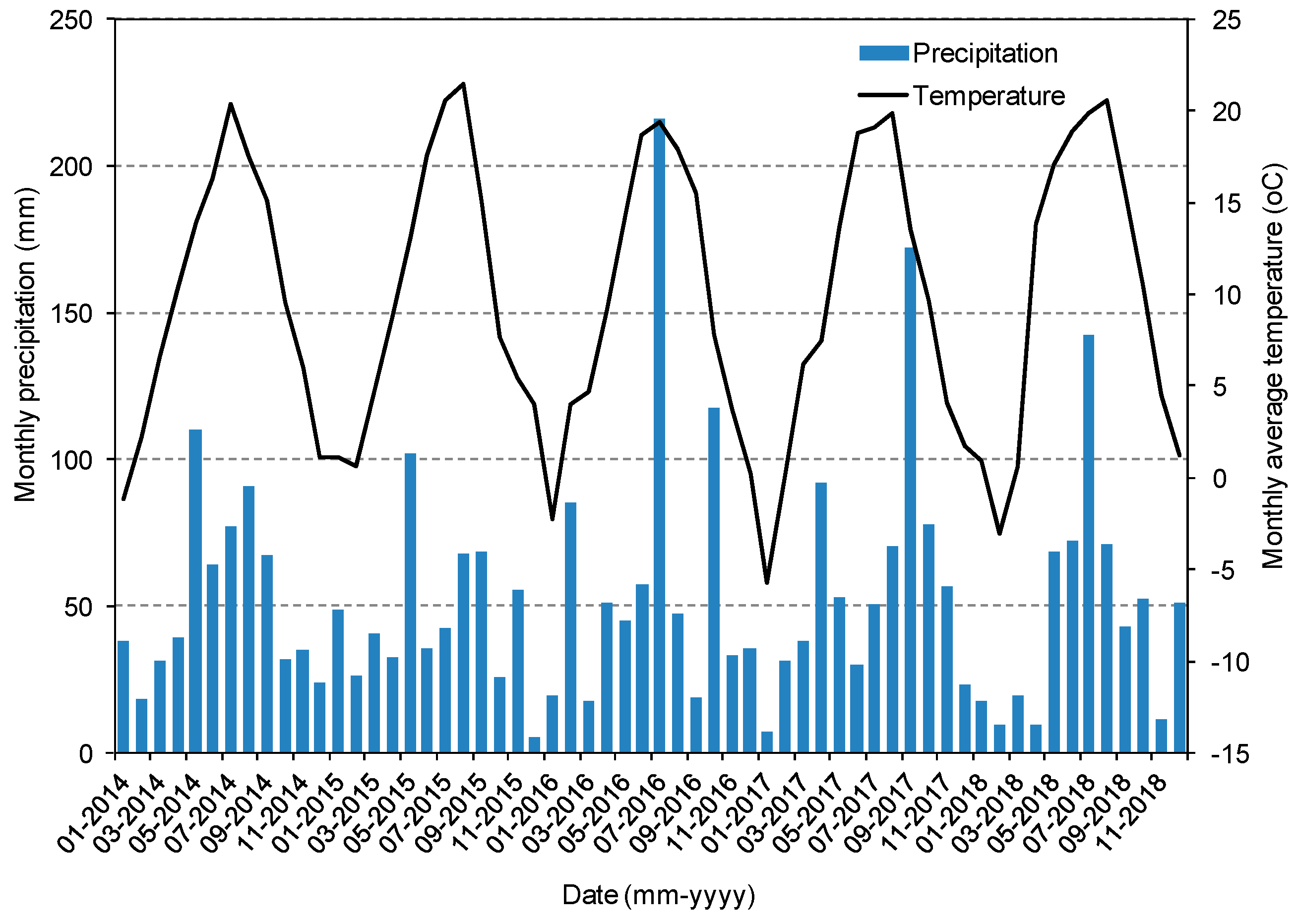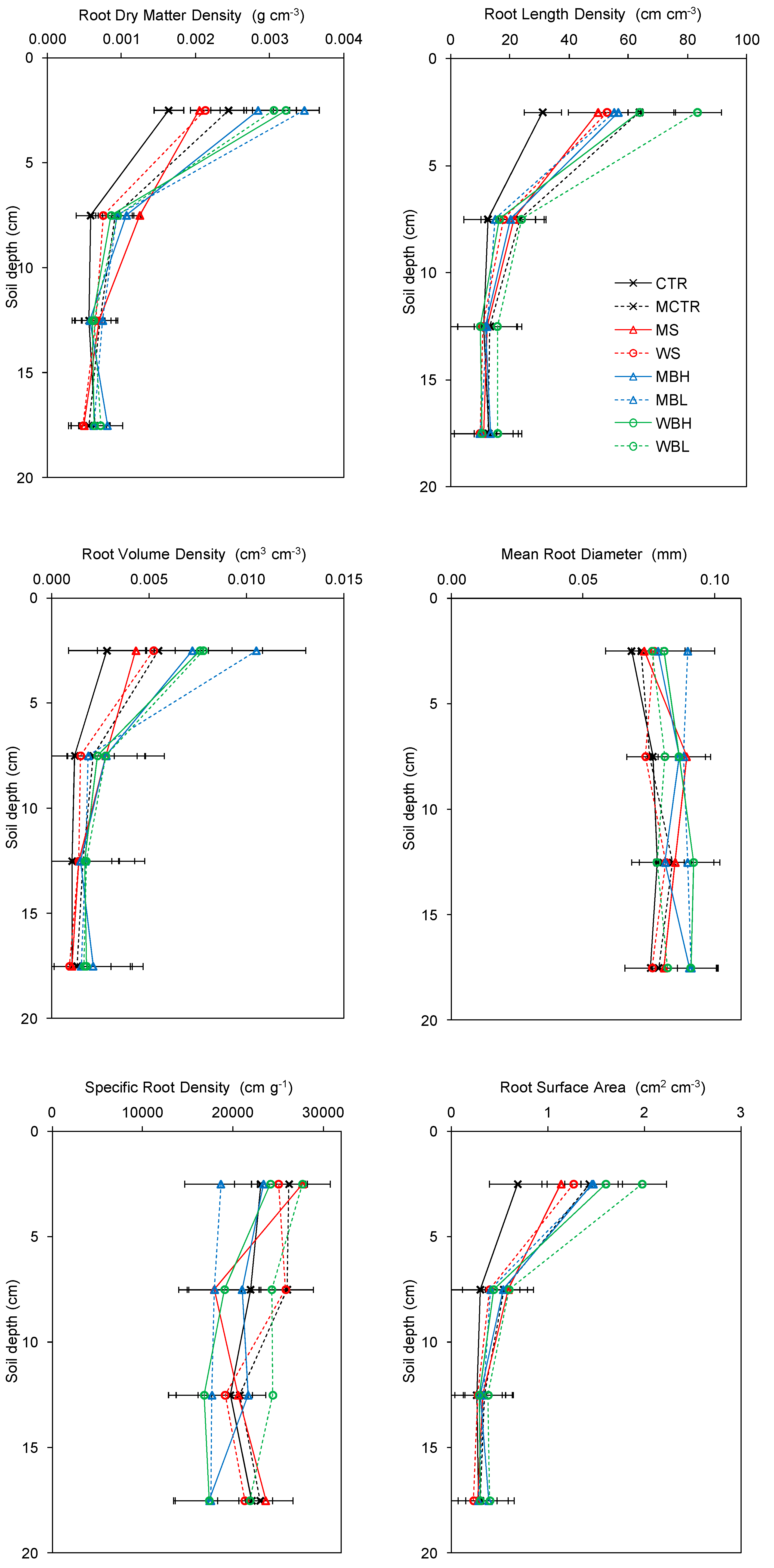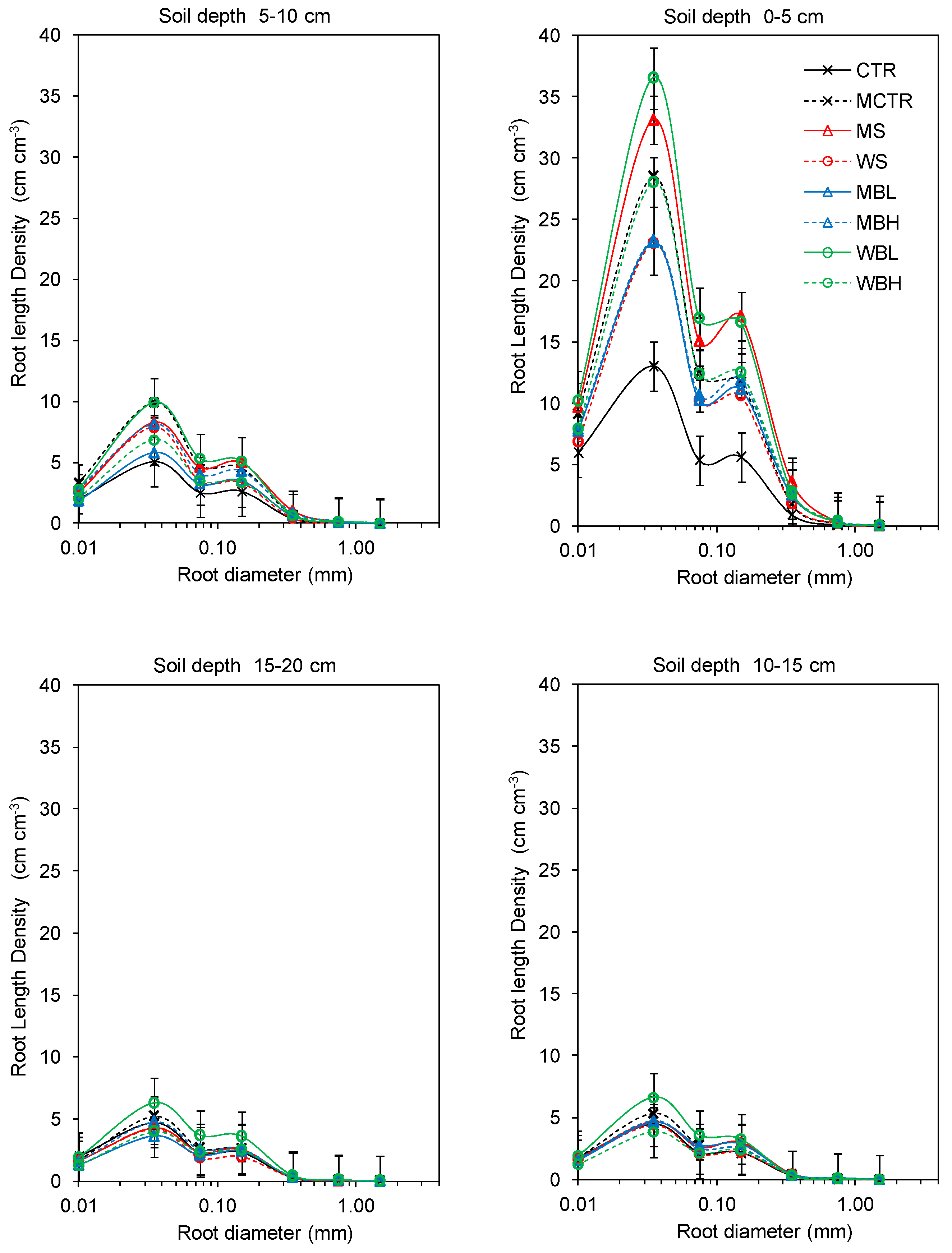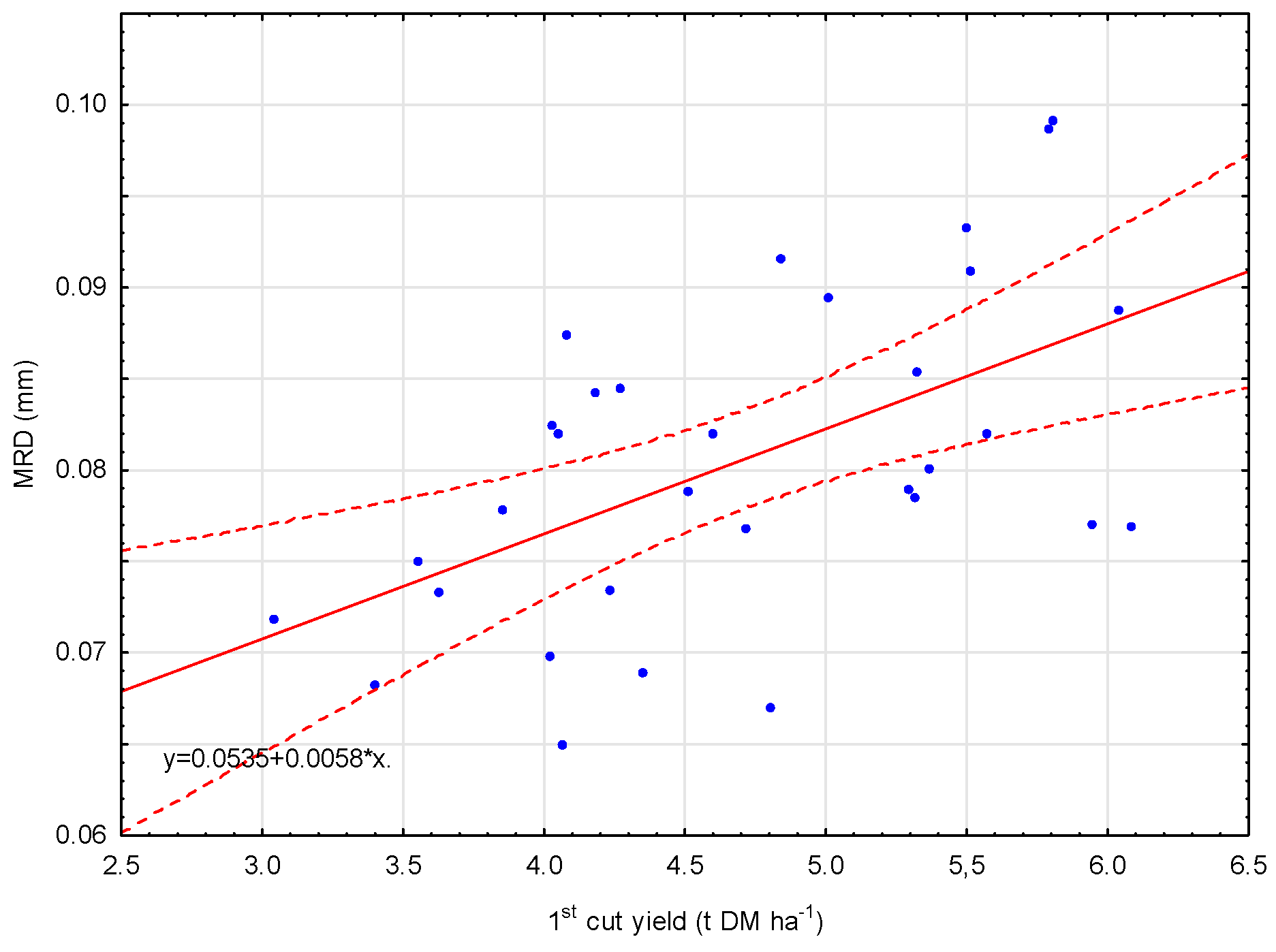Effects of Straw and Biochar Amendments on Grassland Productivity and Root Morphology
Abstract
:1. Introduction
2. Materials and Methods
2.1. Organic Amendments
2.2. Experimental Design and Treatments
2.3. Yield and Plant Species Composition
2.4. Root Measurements
2.5. Statistics
3. Results
3.1. Red Clover/Grass Mixture Yields
3.2. Root System Morphology Characteristics
3.3. Botanical Composition
4. Discussion
4.1. Straw and Biochar Effects on Aboveground Biomass
4.2. Modification of Root Traits
5. Conclusions
Author Contributions
Funding
Conflicts of Interest
References
- Xu, J.; Han, H.; Ning, T.; Li, Z.; Lal, R. Long-term effects of tillage and straw management on soil organic carbon, crop yield, and yield stability in a wheat-maize system. Field Crop. Res. 2019, 233, 33–40. [Google Scholar] [CrossRef]
- Głąb, T.; Kulig, B. Effect of mulch and tillage system on soil porosity under wheat (Triticum aestivum). Soil Tillage Res. 2008, 99, 169–178. [Google Scholar] [CrossRef]
- Wang, H.; Shen, M.; Hui, D.; Chen, J.; Sun, G.; Wang, X.; Lu, C.; Sheng, J.; Chen, L.; Luo, Y.; et al. Straw incorporation influences soil organic carbon sequestration, greenhouse gas emission, and crop yields in a Chinese rice (Oryza sativa L.)—Wheat (Triticum aestivum L.) cropping system. Soil Tillage Res. 2019, 195, 104377. [Google Scholar] [CrossRef]
- Zhang, P.; Chen, X.; Wei, T.; Yang, Z.; Jia, Z.; Yang, B.; Han, Q.; Ren, X. Effects of straw incorporation on the soil nutrient contents, enzyme activities, and crop yield in a semiarid region of China. Soil Tillage Res. 2016, 160, 65–72. [Google Scholar] [CrossRef]
- Zhao, Y.; Li, Y.; Wang, J.; Pang, H.; Li, Y. Buried straw layer plus plastic mulching reduces soil salinity and increases sunflower yield in saline soils. Soil Tillage Res. 2016, 155, 363–370. [Google Scholar] [CrossRef]
- Getahun, G.T.; Kätterer, T.; Munkholm, L.J.; Parvage, M.M.; Keller, T.; Rychel, K.; Kirchmann, H. Short-term effects of loosening and incorporation of straw slurry into the upper subsoil on soil physical properties and crop yield. Soil Tillage Res. 2018, 184, 62–67. [Google Scholar] [CrossRef]
- Huang, S.; Zeng, Y.; Wu, J.; Shi, Q.; Pan, X. Effect of crop residue retention on rice yield in China: A meta-analysis. Field Crop. Res. 2013, 154, 188–194. [Google Scholar] [CrossRef]
- Wu, D.; Wei, Z.; Well, R.; Shan, J.; Yan, X.; Bol, R.; Senbayram, M. Straw amendment with nitrate-N decreased N2O/(N2O+N2) ratio but increased soil N2O emission: A case study of direct soil-born N2 measurements. Soil Biol. Biochem. 2018, 127, 301–304. [Google Scholar] [CrossRef]
- Alpert, P.; Maron, L. Carbon addition as a countermeasure against biological invasion by plants. Biol. Invasions 2000, 2, 33–40. [Google Scholar] [CrossRef]
- Desserud, P.; Naeth, M.A. Establishment of a native bunch grass and an invasive perennial on disturbed land using straw-amended soil. J. Environ. Manag. 2013, 114, 540–547. [Google Scholar] [CrossRef]
- Peake, L.; Freddo, A.; Reid, B.J. Sustaining Soils and Mitigating Climate Change Using Biochar. In Sustainability Science and Technology; De Las Heras, A., Ed.; Taylor&Francis Group, CRC Press: Cleveland, OH, USA, 2014; pp. 109–126. [Google Scholar]
- He, L.; Zhong, Z.; Yang, H. Effects on soil quality of biochar and straw amendment in conjunction with chemical fertilizers. J. Integr. Agric. 2017, 16, 704–712. [Google Scholar] [CrossRef] [Green Version]
- Karhu, K.; Mattila, T.; Bergström, I.; Regina, K. Biochar addition to agricultural soil increased CH4 uptake and water holding capacity–Results from a short-term pilot field study. Agric. Ecosyst. Environ. 2011, 140, 309–313. [Google Scholar] [CrossRef]
- Jeffery, S.; Verheijen, F.G.A.; van der Velde, M.; Bastos, A.C. A quantitative review of the effects of biochar application to soils on crop productivity using meta-analysis. Agric. Ecosyst. Environ. 2011, 144, 175–187. [Google Scholar] [CrossRef]
- Oram, N.J.; van de Voorde, T.F.J.; Ouwehand, G.J.; Bezemer, T.M.; Mommer, L.; Jeffery, S.; Van Groenigen, J.W. Soil amendment with biochar increases the competitive ability of legumes via increased potassium availability. Agric. Ecosyst. Environ. 2014, 191, 92–98. [Google Scholar] [CrossRef] [Green Version]
- Rafique, M.; Ortas, I.; Rizwan, M.; Chaudhary, H.J.; Gurmani, A.R.; Munis, M.F.H. Residual effects of biochar and phosphorus on growth and nutrient accumulation by maize (Zea mays L.) amended with microbes in texturally different soils. Chemosphere 2020, 238, 124710. [Google Scholar] [CrossRef]
- Mierzwa-Hersztek, M.; Gondek, K.; Klimkowicz-Pawlas, A.; Kopeć, M.; Lošák, T. Effect of coapplication of poultry litter biochar and mineral fertilisers on soil quality and crop yield. Zemdirb. Agric. 2018, 105, 203–210. [Google Scholar] [CrossRef]
- Hopkins, A.; Wilkins, R.J. Temperate grassland: Key developments in the last century and future perspectives. J. Agric. Sci. 2006, 144, 503–523. [Google Scholar] [CrossRef]
- Habel, J.C.; Dengler, J.; Janišová, M.; Török, P.; Wellstein, C.; Wiezik, M. European grassland ecosystems: Threatened hotspots of biodiversity. Biodivers. Conserv. 2013, 22, 2131–2138. [Google Scholar] [CrossRef] [Green Version]
- Čámská, K.; Skálová, H. Effect of low-dose N application and early mowing on plant species composition of mesophilous meadow grassland (Arrhenatherion) in Central Europe. Grass Forage Sci. 2012, 67, 403–410. [Google Scholar] [CrossRef]
- Dindová, A.; Hakl, J.; Hrevušová, Z.; Nerušil, P. Relationships between long-term fertilization management and forage nutritive value in grasslands. Agric. Ecosyst. Environ. 2019, 279, 139–148. [Google Scholar] [CrossRef]
- Aydin, I.; Uzun, F. Nitrogen and phosphorate fertilization of rangelands affects yield, forage quality and the botanical composition. Eur. J. Agron. 2005, 23, 8–14. [Google Scholar] [CrossRef]
- Kacorzyk, P.; Głąb, T. Effect of ten years of mineral and organic fertilization on the herbage production of a mountain meadow. J. Elem. 2017, 22, 219–233. [Google Scholar] [CrossRef]
- Wassen, M.J.; Venterink, H.O.; Lapshina, E.D.; Tanneberger, F. Endangered plants persist under phosphorus limitation. Nature 2005, 437, 547–550. [Google Scholar] [CrossRef]
- Oelmann, Y.; Richter, A.K.; Roscher, C.; Rosenkranz, S.; Temperton, V.M.; Weisser, W.W.; Wilcke, W. Does plant diversity influence phosphorus cycling in experimental grasslands? Geoderma 2011, 167–168, 178–187. [Google Scholar] [CrossRef]
- Lee, H.S.; Lee, I.D. Effect of N fertilizer levels on the dry matter yield, quality and botanical composition in eight-species mixtures. Korean J. Anim. Sci. 2000, 42, 727–734. [Google Scholar]
- Van de Voorde, T.F.J.; Bezemer, T.M.; Van Groenigen, J.W.; Jeffery, S.; Mommer, L. Soil biochar amendment in a nature restoration area: Effects on plant productivity and community composition. Ecol. Appl. 2014, 2, 1167–1177. [Google Scholar] [CrossRef] [Green Version]
- Jones, D.L.; Rousk, J.; Edwards-Jones, G.; DeLuca, T.H.; Murphy, D.V. Biochar-mediated changes in soil quality and plant growth in a three year field trial. Soil Biol. Biochem. 2012, 45, 113–124. [Google Scholar] [CrossRef]
- Rondon, M.; Lehmann, J.; Ramírez, J.; Hurtado, M. Biological nitrogen fixation by common beans (Phaseolus vulgaris L.) increases with bio-char additions. Biol. Fertil. Soil 2007, 43, 699–708. [Google Scholar] [CrossRef]
- Schimmelpfennig, S.; Müller, C.; Grünhage, L.; Koch, C.; Kammann, C. Biochar, hydrochar and uncarbonized feedstock application to permanent grassland -Effects on greenhouse gas emissions and plant growth. Agric. Ecosyst. Environ. 2014, 191, 39–52. [Google Scholar] [CrossRef]
- Beltman, B.; Willems, J.H.; Güsewell, S. Flood events overrule fertilizer effects on biomass production and species richness in riverine grasslands. J. Veg. Sci. 2007, 18, 625–634. [Google Scholar] [CrossRef]
- Bardgett, R.D. Linking Aboveground–Belowground Ecology: A Short Historical Perspective. In Aboveground–Belowground Community Ecology. Ecological Studies (Analysis and Synthesis); Ohgushi, T., Wurst, S., Johnson, S., Eds.; Springer: Cham, Switzerland, 2018; Volume 234. [Google Scholar]
- Standardized Product Definition and Product Testing Guidelines for Biochar That is Used in Soil; Final Report; Report No. IBISTD-2.0; International Biochar Initiative: Washington, DC, USA, 2014; Available online: http://www.biochar-international.org/characterizationstandard (accessed on 25 August 2020).
- Gondek, K.; Mierzwa-Hersztek, M. Effect of low-temperature biochar derived from pig manure and poultry litter on mobile and organic matter-bound forms of Cu, Cd, Pb and Zn in sandy soil. Soil Use Manag. 2016, 32, 357–367. [Google Scholar] [CrossRef]
- Lu, H.; Zhang, W.; Wang, S.; Zhuang, L.; Yang, Y.; Qiu, R. Characterization of sewage sludge-derived biochars from different feedstocks and pyrolysis temperatures. J. Anal. Appl. Pyrolysis 2013, 102, 137–143. [Google Scholar] [CrossRef]
- Mendez, A.; Terradillos, M.; Gasco, G. Physicochemical and agronomic properties of biochar from sewage sludge pyrolysed at different temperatures. J. Anal. Appl. Pyrolysis 2013, 102, 124–130. [Google Scholar] [CrossRef]
- Gondek, K.; Baran, A.; Kopeć, M. The effect of low-temperature transformation of mixtures of sewage sludge and plant material on content, leachability and toxicity of heavy metals. Chemosphere 2014, 117, 33–39. [Google Scholar] [CrossRef]
- Domene, X.; Enders, A.; Hanley, K.; Lehmann, J. Ecotoxicological characterization of biochars: Role of feedstock and pyrolysis temperature. Sci. Total Environ. 2015, 512, 552–561. [Google Scholar] [CrossRef] [Green Version]
- IUSS Working Group WRB. World Reference Base for Soil Resources 2014, update 2015. In International Soil Classification System for Naming Soils and Creating Legends for Soil Maps; World Soil Resources Reports No. 106; FAO: Rome, Italy, 2015. [Google Scholar]
- Cayley, J.W.D.; Bird, P.R. Techniques for Measuring Pastures; Pastoral and Veterinary Institute Hamilton: Hamilton, Australia, 1996. [Google Scholar]
- Bohm, W. Methods of Studying Root Systems. Ecological Studies; Springer: Berlin, Germany, 1979; Volume 33. [Google Scholar]
- Smucker, A.J.M.; McBurney, S.L.; Srivastava, A.K. Quantitative separation of roots from compacted soil profiles by the hydropneumatic elutriation system. Agron. J. 1982, 74, 500–503. [Google Scholar] [CrossRef] [Green Version]
- Bauhus, J.; Messier, C. Evaluation of fine root length and diameter measurements obtained using RHIZO image analysis. Agron. J. 1999, 91, 142–147. [Google Scholar] [CrossRef] [Green Version]
- Verlinden, G.; Pycke, B.; Mertens, J.; Debersaques, F.; Verheyen, K.; Baert, G.; Bries, J.; Haesaert, G. Application of humic substances results in consistent increases in crop yield and nutrient uptake. J. Plant Nutr. 2009, 32, 1407–1426. [Google Scholar] [CrossRef]
- Lehmann, J.; Joseph, S. (Eds.) Biochar for Environmental Management. Science, Technology and Implementation; Routledge: London, UK, 2015. [Google Scholar]
- Mierzwa-Hersztek, M.; Gondek, K.; Klimkowicz-Pawlas, A.; Baran, A. Effect of wheat and Miscanthus straw biochars on soil enzymatic activity, ecotoxicity, and plant yield. Int. Agrophysics 2017, 31, 367–375. [Google Scholar] [CrossRef]
- Alburquerque, J.A.; Calero1, J.M.; Barrón, V.; Torrent, J.; del Campillo, M.C.; Gallardo, A.; Villar, R. Effects of biochars produced from different feedstocks on soil properties and sunflower growth. J. Plant Nutr. Soil Sci. 2014, 177, 16–25. [Google Scholar] [CrossRef]
- Reed, E.Y.; Chadwick, D.R.; Hill, P.W.; Jones, D.L. Critical comparison of the impact of biochar and wood ash on soil organic matter cycling and grassland productivity. Soil Biol. Biochem. 2017, 110, 134–142. [Google Scholar] [CrossRef] [Green Version]
- Mevlut, T.R.K.; Ceuk, N.; Bayram, G.; Budakli, E. Effects of nitrogen and phosphorus on botanical composition, yield and nutritive value of rangelands. Asian J. Chem. 2007, 19, 53515359. [Google Scholar]
- Prendergast-Miller, M.T.; Duvall, M.; Sohi, S.P. Biochar–root interactions are mediated by biochar nutrient content and impacts on soil nutrient availability. Eur. J. Soil Sci. 2014, 65, 173–185. [Google Scholar] [CrossRef]
- Xiang, Y.; Deng, Q.; Duan, H.; Guo, Y. Effects of biochar application on root traits: A meta-analysis. GCB Bioenergy 2017, 9, 1563–1572. [Google Scholar] [CrossRef]
- Bonifas, K.D.; Walters, D.T.; Cassman, K.G.; Lindquist, J.L. Nitrogen supply affects root:shoot ratio in corn and velvetleaf (Abutilon theophrasti). Weed Sci. 2005, 53, 670–675. [Google Scholar] [CrossRef] [Green Version]
- McCarthy, M.C.; Enquist, B.J. Consistency between an allometric approach and optimal partitioning theory in global patterns of plant biomass allocation. Funct. Ecol. 2007, 21, 713–720. [Google Scholar] [CrossRef]
- Głąb, T.; Ścigalska, B.; Łabuz, B. Effect of crop rotation on the root system morphology and productivity of triticale (× Triticosecale Wittm.). J. Agric. Sci. 2014, 152, 642–654. [Google Scholar] [CrossRef]
- De Giorgio, D.; Fornaro, F. Nitrogen fertilization and root growth dynamics in durum wheat. Ital. J. Agron. 2012, 7, 207–213. [Google Scholar]
- Fageria, N.K.; Moreira, A. The Role of Mineral Nutrition on Root Growth of Crop Plants (Book). Adv. Agron. 2011, 110, 251–331. [Google Scholar]
- Głąb, T. Effect of tractor traffic and N fertilization on the root morphology of grass/red clover mixture. Soil Tillage Res. 2013, 134, 163–171. [Google Scholar] [CrossRef]
- Kulmatiski, A.; Adler, P.B.; Stark, J.M.; Tredennick, A.T. Water and nitrogen uptake are better associated with resource availability than root biomass. Ecosphere 2017, 8, e01738. [Google Scholar] [CrossRef]
- Sainju, U.M.; Allen, B.L.; Lenssen, A.W.; Ghimire, R.P. Root biomass, root/shoot ratio, and soil water content under perennial grasses with different nitrogen rates. Field Crop. Res. 2017, 210, 183–191. [Google Scholar] [CrossRef] [Green Version]




| Parameter | Unit | Triticum Aestivum L. | Miscanthus × Giganteus | ||
|---|---|---|---|---|---|
| Straw | Biochar | Straw | Biochar | ||
| pH (H2O) | 5.84 ± 0.15 | 6.52 ± 0.60 | 6.18 ± 0.43 | 6.28 ± 0.42 | |
| EC * | mS·cm−1 | 4.48 ± 0.21 | 378 ± 21 | 3.23 ± 0.45 | 345 ± 18 |
| DM | g·kg−1 | 952 ± 0.2 | 966 ± 2 | 947 ± 0.3 | 977 ± 1 |
| Ash | g·kg−1 DM | 59 ± 2 | 134 ± 5 | 54 ± 1 | 87 ± 3 |
| Corg. | g·kg−1 DM | 441 ± 2 | 628 ± 2 | 456 ± 2 | 651 ± 6 |
| Ntotal | g·kg−1 DM | 7.16 ± 0.32 | 12.4 ± 0.36 | 3.97 ± 0.29 | 7.31 ± 0.09 |
| K | g·kg−1 DM | 4.95 ± 0.66 | 11.9 ± 0.29 | 1.33 ± 0.06 | 2.81 ± 0.17 |
| P | g·kg−1 DM | 1.04 ± 0.05 | 1.17 ± 0.04 | 0.73 ± 0.04 | 0.94 ± 0.06 |
| Parameter | Unit | Value |
|---|---|---|
| pH (H2O) | 6.46 ± 0.02 | |
| pH (KCl) | 5.59 ± 0.01 | |
| Corg. | g kg−1 | 8.87 ± 0.07 |
| Ntotal | g kg−1 | 0.98 ± 0.01 |
| C:N | 9.1 | |
| P | g kg−1 | 2.09 ± 0.02 |
| K | g kg−1 | 1.66 ± 0.01 |
| Ca | g kg−1 | 1.38 ± 0.01 |
| Mg | g kg−1 | 0.81 ± 0.01 |
| EC | mS cm−1 | 0.02 ± 0.00 |
| Solid particle density | g cm−3 | 2.65 ± 0.06 |
| Sand | g kg−1 | 730 |
| Silt | g kg−1 | 150 |
| Clay | g kg−1 | 120 |
| Factor | df | RLD | RDMD | RVD | MRD | SRL | RSA | RSR | |||||||
|---|---|---|---|---|---|---|---|---|---|---|---|---|---|---|---|
| F | p | F | p | F | p | F | p | F | p | F | p | F | p | ||
| Amendment | 1 | 2.346 | 0.026 | 1.005 | 0.429 | 1.657 | 0.123 | 3.00 | 0.005 | 1.898 | 0.073 | 2.428 | 0.021 | 1.452 | 0.215 |
| Depth | 1 | 80.510 | <0.001 | 45.665 | <0.001 | 28.221 | <0.001 | 1.86 | 0.138 | 2.720 | 0.046 | 73.593 | <0.001 | 75.658 | <0.001 |
| A × D | 1 | 1.058 | 0.398 | 0.644 | 0.879 | 0.825 | 0.685 | 0.34 | 0.996 | 0.360 | 0.995 | 1.073 | 0.382 | 0.654 | 0.958 |
| Treatment | 1st cut | 2nd cut | 3rd cut | Total |
|---|---|---|---|---|
| CTR | 3.69 ± 0.86 b | 2.28 ± 0.65 c | 1.45 ± 0.45 a | 7.42 ± 1.21 c |
| MCTR | 4.20 ± 0.90 ab | 2.66 ± 0.52 bc | 1.39 ± 0.43 a | 8.25 ± 1.26 bc |
| MS | 4.85 ± 0.95 a | 3.38 ± 0.65 ab | 1.53 ± 0.48 a | 9.77 ± 1.12 ab |
| WS | 4.91 ± 0.89 a | 3.48 ± 0.64 a | 1.46 ± 0.46 a | 9.85 ± 1.32 a |
| MBH | 5.18 ± 0.98 a | 3.24 ± 0.068 ab | 1.62 ± 0.30 a | 10.03 ± 1.31 a |
| MBL | 4.50 ± 0.87 a | 2.95 ± 0.071 ab | 1.43 ± 0.38 a | 8.89 ± 1.22 ab |
| WBH | 4.81 ± 0.81 a | 3.19 ± 0.069 ab | 1.57 ± 0.42 a | 9.57 ± 1.23 ab |
| WBL | 4.53 ± 0.92 a | 2.62 ± 0.63 bc | 1.48 ± 0.39 a | 8.64 ± 1.09 abc |
| Treatments | RLD (cm cm−3) | RDMD (mg cm−3) | RVD (cm3 cm−3) | RSA (cm2 cm−3) | MRD (mm) | SRL (cm g−1) | RSR |
|---|---|---|---|---|---|---|---|
| CTR | 16.9 ± 2.12 c | 0.00086 ± 0.00015 a | 0.00154 ± 0.00020 a | 0.382 ± 0.056 c | 0.0747 ± 0.0084 c | 21688 ± 3531 a | 0.691 ± 0.089 c |
| MCTR | 28.3 ± 2.32 ab | 0.00116 ± 0.00010 a | 0.00264 ± 0.00021 a | 0.653 ± 0.056 ab | 0.0775 ± 0.0098 c | 23985 ± 3689 a | 0.842 ± 0.096 ab |
| MS | 23.7 ± 2.06 bc | 0.00113 ± 0.00008 a | 0.00239 ± 0.00023 a | 0.579 ± 0.059 bc | 0.0821 ± 0.0087 abc | 22440 ± 3265 a | 0.691 ± 0.078 cb |
| WS | 22.9 ± 2.21 bc | 0.00101 ± 0.00009 a | 0.00227 ± 0.00029 a | 0.542 ± 0.061 bc | 0.0772 ± 0.0085 c | 22819 ± 2298 a | 0.612 ± 0.081 c |
| MBH | 25.5 ± 2.16 abc | 0.00132 ± 0.00011 a | 0.00341 ± 0.00032 a | 0.668 ± 0.071 ab | 0.0828 ± 0.0094 abc | 20861 ± 2873 a | 0.792 ± 0.086 ab |
| MBL | 23.1 ± 2.35 bc | 0.00145 ± 0.00014 a | 0.00391 ± 0.00035 a | 0.622 ± 0.0.059 abc | 0.0904 ± 0.010 a | 17955 ± 2951 a | 0.976 ± 0.098 a |
| WBH | 25.3 ± 2.41 bc | 0.00134 ± 0.00012 a | 0.00351 ± 0.00033 a | 0.656 ± 0.064 ab | 0.0883 ± 0.0099 ab | 24566 ± 3941 a | 0.835 ± 0.084 ab |
| WBL | 34.7 ± 2.98 a | 0.00133 ± 0.00011 a | 0.00338 ± 0.00028 a | 0.838 ± 0.059 a | 0.0800 ± 0.0079 bc | 19352 ± 3245 a | 0.930 ± 0.086 a |
| RLD | RDMD | MRD | RVD | RSA | SRL | |
|---|---|---|---|---|---|---|
| 1st cut | −0.3109 | 0.1762 | 0.5238 * | 0.1715 | −0.1349 | −0.0473 |
| 2nd cut | −0.1308 | −0.1480 | 0.1694 | 0.0254 | −0.0918 | 0.0193 |
| 3rd cut | −0.1879 | −0.2201 | 0.0420 | −0.0827 | −0.1815 | 0.0332 |
| Treatment | CTR | MCTR | WS | MS | WBH | MBH | WBL | MBL |
|---|---|---|---|---|---|---|---|---|
| Empty space | 6.4 ± 1.2 | 5.9 ± 1.6 | 8.9 ± 1.9 | 6.0 ± 1.4 | 4.3 ± 1.8 | 5.8 ± 1.6 | 7.3 ± 1.9 | 4.8 ± 1.9 |
| Grasses | ||||||||
| Festuca arundinacea Schreb. | 53.0 ± 1.5 | 46.1 ± 1.6 | 50.0 ± 1.2 | 66.1 ± 1.5 | 65.6 ± 1.5 | 58.6 ± 1.8 | 58.4 ± 1.9 | 61.0 ± 1.6 |
| Dactylis glomerata L. | 0.0 ± 0.0 | 6.3 ± 1.4 | 14.0 ± 1.6 | 3.3 ± 1.8 | 2.3 ± 1.4 | 1.8 ± 1.4 | 9.5 ± 1.6 | 2.2 ± 1.4 |
| Lolium multiflorum Lam. | 0.0 ± 0.0 | 17.1 ± 1.6 | 9.1 ± 1.1 | 8.4 ± 1.6 | 1.5 ± 1.2 | 0.0 ± 0.0 | 1.9 ± 1.4 | 1.8 ± 0.8 |
| Holcus lanatus L. | 1.3 ± 1.2 | 0.0 ± 0.0 | 0.0 ± 0.0 | 0.0 ± 0.0 | 0.0 ± 0.0 | 0.0 ± 0.0 | 0.0 ± 0.0 | 0.0 ± 0.0 |
| Legumes | ||||||||
| Trifolium pratense L. | 8.4 ± 1.3 | 0.0 ± 0.0 | 0.0 ± 0.0 | 1.6 ± 1.3 | 1.9 ± 1.4 | 0.0 ± 0.0 | 3.1 ± 1.7 | 0.0 ± 0.0 |
| Forbs | ||||||||
| Stellaria graminea L. | 29.21.4 | 18.4 ± 1.8 | 15.5 ± 0.8 | 12.1 ± 1.1 | 22.8 ± 1.6 | 30.8 ± 1.4 | 17.4 ± 1.5 | 23.4 ± 1.1 |
| Rumex acetosa L. | 1.2 ± 1.8 | 3.2 ± 1.7 | 0.0 ± 0.0 | 1.0 ± 0.2 | 0.0 ± 0.0 | 1.0 ± 0.8 | 0.0 ± 0.0 | 1.3 ± 0.8 |
| Capsella bursa-pastoris (L.) Medik. | 0.6 ± 1.1 | 0.0 ± 0.0 | 0.6 ± 1.1 | 0.0 ± 0.0 | 0.4 ± 1.1 | 1.0 ± 0.9 | 0.0 ± 0.0 | 1.0 ± 0.8 |
| Geranium pusillum L. | 0.0 ± 0.0 | 0.0 ± 0.0 | 1.4 ± 1.2 | 0.0 ± 0.0 | 1.3 ± 1.3 | 0.4 ± 1.1 | 0.0 ± 0.0 | 2.6 ± 0.9 |
| Melandrium pratense Röhl. | 0.0 ± 0.0 | 1.3 ± 1.4 | 0.0 ± 0.0 | 1.6 ± 1.4 | 0.0 ± 0.0 | 0.4 ± 1.1 | 2.4 ± 1.5 | 0.0 ± 0.0 |
| Ranunculus acris L. | 0.0 ± 0.0 | 1.7 ± 1.3 | 0.0 ± 0.0 | 0.0 ± 0.0 | 0.0 ± 0.0 | 0.0 ± 0.0 | 0.0 ± 0.0 | 0.0 ± 0.0 |
| Senecio vulgaris L. | 0.0 ± 0.0 | 0.0 ± 0.0 | 0.5 ± 1.1 | 0.0 ± 0.0 | 0.0 ± 0.0 | 0.4 ± 1.1 | 0.0 ± 0.0 | 1.8 ± 1.4 |
Publisher’s Note: MDPI stays neutral with regard to jurisdictional claims in published maps and institutional affiliations. |
© 2020 by the authors. Licensee MDPI, Basel, Switzerland. This article is an open access article distributed under the terms and conditions of the Creative Commons Attribution (CC BY) license (http://creativecommons.org/licenses/by/4.0/).
Share and Cite
Głąb, T.; Gondek, K.; Mierzwa-Hersztek, M.; Szewczyk, W. Effects of Straw and Biochar Amendments on Grassland Productivity and Root Morphology. Agronomy 2020, 10, 1794. https://doi.org/10.3390/agronomy10111794
Głąb T, Gondek K, Mierzwa-Hersztek M, Szewczyk W. Effects of Straw and Biochar Amendments on Grassland Productivity and Root Morphology. Agronomy. 2020; 10(11):1794. https://doi.org/10.3390/agronomy10111794
Chicago/Turabian StyleGłąb, Tomasz, Krzysztof Gondek, Monika Mierzwa-Hersztek, and Wojciech Szewczyk. 2020. "Effects of Straw and Biochar Amendments on Grassland Productivity and Root Morphology" Agronomy 10, no. 11: 1794. https://doi.org/10.3390/agronomy10111794
APA StyleGłąb, T., Gondek, K., Mierzwa-Hersztek, M., & Szewczyk, W. (2020). Effects of Straw and Biochar Amendments on Grassland Productivity and Root Morphology. Agronomy, 10(11), 1794. https://doi.org/10.3390/agronomy10111794







